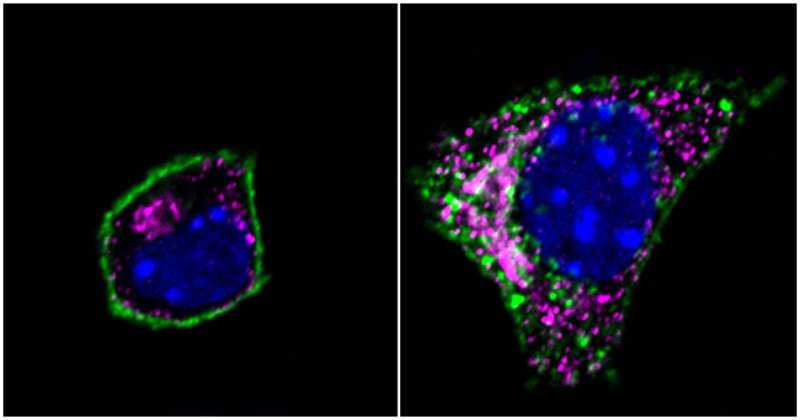This article has been reviewed according to Science X's editorial process and policies. Editors have highlighted the following attributes while ensuring the content's credibility:
fact-checked
peer-reviewed publication
trusted source
proofread
Specific genetic variant may help prevent obesity

A preclinical study by Weill Cornell Medicine investigators shows that a specific human genetic variant of a receptor that stimulates insulin release may help individuals resist obesity. The researchers discovered that this variant behaves differently in the cell, possibly contributing to more efficient metabolism.
The study, posted online in Molecular Metabolism, provides new insight into how human genetic variations affect an individual's susceptibility to weight gain. The researchers developed mice with a human genetic variant in the glucose-dependent insulinotropic polypeptide (GIP) receptor associated with leaner body mass index (BMI).
They found that the mice were better at processing sugar and staying leaner than mice with a different, more common receptor variant. The discovery may point to new potential strategies to treat obesity, which affects more than 100 million adults in the United States, according to the Centers for Disease Control and Prevention.
"Our work demonstrates how basic science research can yield important insights about complex biology," said the study's senior author Dr. Timothy McGraw, a professor of biochemistry in cardiothoracic surgery and in biochemistry at Weill Cornell Medicine. "These GIP receptors and their behavior at the cellular level profoundly impact metabolism and weight regulation."
Genetic variants of the GIP receptor
Genetic variants are differences in DNA sequence that occur naturally between individuals in a given population. Genome-wide association studies, which use statistics to carefully link genetic variants to particular traits, show about 20 percent of people of European descent have one copy of the GIP receptor with the Q354 gene variant, and about 5 percent have two copies of the variant. The GIP receptor interacts with a hormone released in response to glucose levels after a meal.
"Studies suggest that people with at least one copy of this GIP receptor variant have altered metabolism that reduces their risk of developing obesity," said the study's lead author, Dr. Lucie Yammine, a post-doctoral associate in biochemistry at Weill Cornell Medicine.
To understand how this gene variant may decrease the risk of obesity, the team used CRISPR-Cas9 technology to genetically engineer mice with the variant in the gene encoding the GIP receptor, similar to the human version. They found that female mice with the variant were leaner on a typical mouse diet than female litter mates without it.
Male mice with the gene variant were about the same weight as litter mates without it while consuming a regular diet, but the gene variant protected them from weight gain when fed a high-fat diet, which caused obesity in litter mates.
"We found that a change in one amino acid in the GIP receptor gene affected the whole body in terms of weight," Dr. Yammine said. Mice with the variant were more sensitive to the GIP hormone that triggers insulin release, which controls blood sugar levels and helps the body convert food into energy.
How the variant may provide an advantage against obesity
The researchers compared what happened to mouse cells with and without the variant when exposed to glucose or the GIP hormone. Pancreatic cells from mice with the genetic variant produced more insulin in response to both glucose and the GIP hormone, which may explain why they are better at processing glucose.
"What's interesting about these receptors is their location in the cell has a big impact on how they signal and their activity," Dr. McGraw said. He explained that when the GIP hormone binds to the receptor, the receptor moves from the cell surface to inside the cell. When the GIP hormone eventually falls off the receptor, the receptor returns to the cell surface.
The team found that the GIP receptor variant stays inside the cell compartment four times longer than the typical receptor. Dr. McGraw suggested that this may allow the receptor to send more messages to the machinery inside cells, which helps process sugar more efficiently.
Still, more research is needed to confirm the effects of this variant on the receptor's behavior. The researchers also want to learn if there are differences in the receptor's behavior in other cell types, like brain cells, which play a crucial role in regulating hunger.
Recently, the Food and Drug Administration has approved several weight loss drugs that mimic natural hormones in the body and interact with receptors like GIP, including semaglutide (Wegovy) and tirzepatide (Zepbound). This has increased the interest in studying new ways to target the GIP receptor for obesity.
"Our work suggests that the movement of the receptor from the cell surface to the interior is an important factor in controlling metabolism. Therefore, drugs regulating the GIP receptor behavior and location could provide an important new avenue to combat obesity," said Dr. Yammine.
In the meantime, Dr. McGraw noted that it is essential to understand how people with different genetic variants in the GIP receptor respond to currently available weight loss medications. "A better appreciation of how different variants of receptors impact metabolism might allow for a precision medicine approach—matching a specific drug to a genetic variant—for weight loss," he said.
More information: Lucie Yammine et al, Spatiotemporal regulation of GIPR signaling impacts glucose homeostasis as revealed in studies of a common GIPR variant, Molecular Metabolism (2023). DOI: 10.1016/j.molmet.2023.101831




















